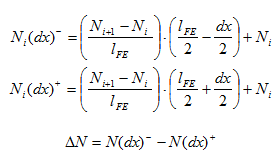

|
||
|
|
||
SCIA Engineer calculates shear stress in joint of phased cross-sections.
|
dx/h |
See paragraph Shear stress calculated from the difference in axial forces (below). |
|
Values |
Two values are available: shear stress and increment of normal forces |
Select function Shearstress (just click the function, do not open it by double-clicking).
Adjust the parameters of the function.
If required, redraw the screen using button Redraw in the Property window.
Review the results.
The shear stress calculated by function Shear stress is determine from the difference of axial forces along the length of the beam. The calculation of shear stress in a joint from the difference of axial forces is the same as the Grasshof theory, but it is applicable only to lateral load. This theory cannot be applied for the effects of a longitudinal load (e.g. shrinkage and creep of concrete between two cross-section phases).
where  are resultants of axial forces in individual cross-section phases.
are resultants of axial forces in individual cross-section phases.
Joint 1

Joint 2

or

1) In the Result service it is possible to obtain the values of axial forces in individual cross-section phases.
2) These values of axial forces are averaged along the length of the finite element (if the values in the start-point and the end-point differ) and this averaged value is put to the centre of the finite element.

3) A function is created that passes through the centres of the finite elements (to make it simpler, the y-axis is placed to the centre of the i-th element). The value of lFE is the distance between the adjacent elements Ni and Ni+1 ==> the length of the finite element.

4) The above described function is used to calculate the value of axial force in the section-being-evaluated between the finite elements (in the distance equal to the half of the finite element length).

5) The value of N(dx) is the starting value for the calculation of shear in the joint in the section-being-evaluated.
6) Next, the difference in the axial force  along the segment length dx. We obtain the value of
along the segment length dx. We obtain the value of  when we subtract the values of axial forces in the distance of dx/2 to the right and to the left from the section-being-evaluated, respectively.
when we subtract the values of axial forces in the distance of dx/2 to the right and to the left from the section-being-evaluated, respectively.

the segment dx is determined using the user-defined ratio dx/h (see the property dialogue of the Shear stress function), where h is the total height of the cross-section.
7) The shear stress is then calculated:

with bj being the width of the joint.